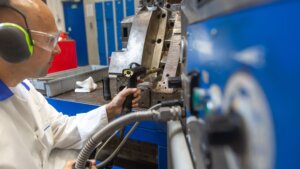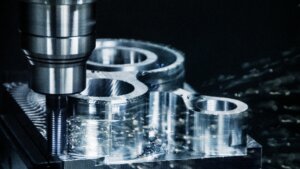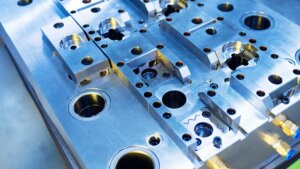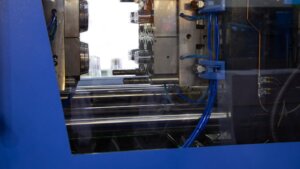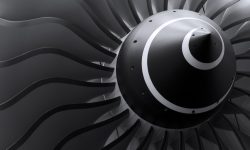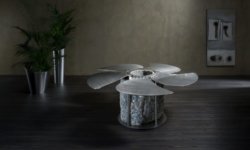In the intricate world of manufacturing, molding stands out as a cornerstone technique, pivotal across a spectrum of industries. From the minutiae of micro-components to the expanse of automotive parts, molding has been instrumental in shaping not only materials but also the evolution of modern manufacturing.
What is Molding?
Molding, often interchangeably used with ‘moulding’, is a manufacturing process of shaping materials into desired forms. This transformation is achieved by introducing a raw material into a mold – a matrix that dictates the shape and size of the final product.
Molding’s versatility allows it to straddle the line between art and industry, making it a subject of both technical and creative interest.
What are the Different Types of Molding Processes?
The world of molding is diverse, encompassing various techniques each suited to specific applications and materials. Understanding these types helps in selecting the right method for a project.
Injection Molding
At the heart of many manufacturing processes lies injection molding. The Injection molding process involves injecting molten material into a mold under high pressure. It’s a go-to method for mass production, particularly with plastics, due to injection molding machines efficiency and ability to produce detailed, complex shapes.
Advantages
- Precision: Injection molding can achieve intricate designs with high accuracy.
- Efficiency: High production rates make it ideal for large-scale manufacturing.
- Material Variety: Injection molds can be produces from a wide range of materials, from plastics to metals.
Limitations
- Initial Costs: The cost of tooling and setup can be high.
- Design Restrictions: While versatile, it requires careful design planning to avoid defects.
Applications
- Automotive: Producing components like dashboards and bumpers.
- Consumer Goods: Creating everything from toys to household items.
Reaction Injection Molding
Reaction Injection Molding (RIM) is a unique process that involves the high-pressure injection of reactive materials into a mold. Unlike traditional injection molding, RIM utilizes low-viscosity liquid polymers that react chemically within the mold, creating strong, lightweight, and complex parts.
Advantages
- Lightweight Products: Ideal for applications where weight is a critical factor.
- Complex Geometries: Capable of producing intricate shapes with fine details.
- Material Efficiency: Low waste production due to precise injection methods.
Limitations
- Material Restrictions: Limited to specific reactive polymers.
- Higher Cycle Times: Due to chemical reactions required for curing.
Common Applications
- Automotive Components: Producing bumpers and fenders with high impact resistance.
- Medical Devices: Ideal for lightweight, durable medical equipment parts.
Blow Molding
Blow molding, a process distinct in its use of air pressure, transforms plastic into hollow objects. This technique begins with melting plastic and forming it into a parison, which is then clamped into a mold. Air is blown into the parison, inflating it to the mold’s shape, akin to balloon artistry in plastics.
Advantages
- High Production Speed: Suitable for mass production of hollow objects.
- Versatility: Can produce a range of sizes and shapes, from small bottles to large containers.
- Cost-Effectiveness: Lower tooling costs compared to other molding processes.
Limitations
- Wall Thickness Variability: Challenges in maintaining uniform wall thickness.
- Limited to Hollow Parts: Cannot be used for solid objects.
Common Applications
- Beverage Bottles: Producing water, soft drink, and other beverage containers.
- Automotive Fuel Tanks: Manufacturing hollow, durable fuel tanks.
Compression Molding
Compression molding is a process where a material, often a thermoset plastic or a rubber compound, is placed in a heated mold cavity. The mold is then closed with a top force or plug member, pressure is applied to force the material into contact with all mold areas, and heat and pressure are maintained until the molding material has cured.
Advantages
- High Volume, Low Cost: Efficient for large-scale production of similar parts.
- Good Mechanical Properties: Produces parts with excellent strength and durability.
- Material Diversity: Suitable for a wide range of materials, including high-strength composites.
Limitations
- Limited Complexity: Not ideal for parts with intricate designs or undercuts.
- Longer Cycle Times: Due to the heating and curing process.
Common Applications
- Electrical Components: Suitable for high-strength, insulative parts.
- Automotive Parts: Producing large, durable components like car hoods and fenders.
Extrusion Molding
Extrusion molding is a process distinguished by its continuous output of shaped products. In this method, raw material, often plastic, is heated and pushed through a die, creating long, consistent sections. This continuous approach is akin to a high-tech version of a pasta maker, but for industrial materials.
Advantages
- Consistent Quality: Ensures uniformity in the cross-section of products.
- High Efficiency: Suitable for long runs, producing continuous shapes.
- Material Versatility: Accommodates a wide range of thermoplastic and thermosetting materials.
Limitations
- Limited Shape Complexity: Best suited for products with constant cross-sections.
- Initial Setup Costs: Requires specific dies and equipment.
Common Applications
- Construction Materials: Creating PVC piping, window frames, and siding.
- Automotive Trims: Producing consistent, high-quality trims and seals.
Rotational Molding (Rotomolding)
Rotational Molding, often referred to as rotomolding, involves a heating process where a mold rotates on multiple axes, distributing the plastic evenly. This technique excels in creating large, hollow, and one-piece items, making it a unique player in the molding arena.
Advantages
- Seamless Products: Produces stress-free, uniform hollow parts.
- Design Flexibility: Allows for complex shapes and sizes, including double-walled constructions.
- Cost-Effective Tooling: Lower mold costs compared to other methods.
Limitations
- Material Constraints: Primarily used with certain types of polyethylene.
- Longer Cycle Times: Due to the rotational and cooling processes involved.
Common Applications
- Storage Tanks: Ideal for large water and fuel tanks.
- Leisure Products: Used in manufacturing kayaks, play balls, and outdoor furniture.
Transfer Molding
Transfer Molding combines aspects of compression and injection molding. It begins with placing a pre-measured amount of molding material into a chamber. Under heat and pressure, the material is then forced into the mold cavity. This process is especially adept at handling intricate designs and tighter tolerances.
Advantages
- High Precision: Suitable for detailed and complex parts.
- Material Efficiency: Reduces waste as excess material can be reused.
- Shorter Cycle Times: Faster than compression molding, making it more efficient for certain applications.
Limitations
- Limited to Smaller Parts: Not as effective for very large components.
- Higher Tooling Costs: More intricate molds increase initial investment.
Common Applications
- Electronic Components: Ideal for producing intricate parts like connectors and switches.
- Automotive Parts: Used for making precision components such as valves and gears.
Thermoforming
Thermoforming is a process where a plastic sheet is heated to a pliable forming temperature, formed to a specific shape in a mold, and trimmed to create a usable product. This technique, akin to sculpting with heat and precision, allows for the creation of larger and more intricate items.
Advantages
- Design Flexibility: Capable of producing large and intricate designs.
- Cost-Effective: Lower tooling costs compared to other molding methods.
- Quick Prototyping: Ideal for rapid development and testing of parts.
Limitations
- Thickness Variability: Challenges in maintaining uniform material thickness.
- Limited Material Options: Best suited for specific types of thermoplastic sheets.
Common Applications
- Packaging Materials: Extensively used in creating blister packs and clamshells.
- Automotive Panels: Suitable for larger, non-structural components.
Vacuum Forming
Vacuum forming, a simplified version of thermoforming, involves heating a plastic sheet until soft, then draping it over a mold and applying vacuum to suction the sheet into the mold. This method elegantly marries simplicity with efficiency, creating a myriad of products in diverse industries.
Advantages
- Rapid Tooling Changes: Allows for quick transitions between different mold designs.
- Cost-Efficiency: Lower operational costs due to simplicity of the process.
- Versatility: Suitable for small to medium-sized production runs.
Limitations
- Detail Restrictions: Less capable of producing extremely detailed parts.
- Material Limitations: Most effective with certain types of thermoplastic materials.
Common Applications
- Product Packaging: Ideal for creating detailed and custom packaging solutions.
- Automotive Parts: Manufacturing non-structural panels and trims.
Insert Molding
Insert molding is a process where a pre-made part is placed into a mold and then encapsulated with a plastic resin. This method, blending the strength of metal and the flexibility of plastic, is a testament to the innovation in modern manufacturing techniques.
Advantages
- Enhanced Strength: Combines the strength of the insert material with the plastic.
- Reduced Assembly Time: Integrates multiple components in a single process.
- High Durability: Creates parts that are robust and long-lasting.
Limitations
- Insert Material Restrictions: Requires careful selection of insert materials compatible with the plastic.
- Precise Alignment Needed: Demands high precision in insert placement.
Common Applications
- Electronic Devices: Embedding metal parts in plastic housings for improved connectivity.
- Medical Equipment: Manufacturing durable components with integrated metal parts for enhanced functionality.
Foam Molding
Foam molding is a process involving the creation of lightweight, porous parts made from foamed plastic. This is achieved by mixing a polymer with a gas under pressure, then allowing it to expand within a mold. The process results in components that combine the strength of plastic with the lightness of air, much like creating a sponge but with engineered precision.
Advantages
- Weight Reduction: Produces extremely lightweight parts.
- Insulation Properties: Foam structures provide excellent thermal and acoustic insulation.
- Versatility: Suitable for a wide range of applications, from packaging to structural components.
Limitations
- Porosity Control: Requires precise control to achieve consistent cell structure.
- Material Specificity: Limited to certain types of foamable polymers.
Common Applications
- Automotive Parts: Used for lightweight, insulative interior components.
- Packaging Solutions: Ideal for protective packaging due to shock absorption qualities.
Matrix Molding
Matrix molding, often used in composite material fabrication, involves embedding reinforcement fibers within a liquid matrix material, which then hardens to form a solid composite. This process, akin to a symphony of strength and flexibility, blends different materials to achieve properties unattainable by individual components alone.
Advantages
- Enhanced Strength: Creates composites with high strength-to-weight ratios.
- Customizable Properties: Allows for tailoring material properties by adjusting the matrix and fibers.
- Design Flexibility: Suitable for complex shapes and sizes.
Limitations
- Process Complexity: Requires precise control of material ratios and curing conditions.
- Higher Production Costs: Due to the materials and precision involved.
Common Applications
- Aerospace Components: Ideal for strong, lightweight parts like aircraft panels.
- Sporting Goods: Used in manufacturing high-performance equipment such as bicycle frames.
Bladder Molding
Bladder molding is a process where an inflatable bladder is used to apply pressure from within a mold. Typically used in the production of hollow, complex shapes, this method involves placing a preformed sheet of material into a mold, then inflating a bladder inside to push the material against the mold walls.
Advantages
- High Precision: Capable of producing complex shapes with tight tolerances.
- Uniform Wall Thickness: The internal pressure ensures consistent wall thickness throughout the part.
- Material Efficiency: Reduces waste by precise material placement and usage.
Limitations
- Limited Size Range: More suited to smaller, intricate components.
- Bladder Maintenance: Requires careful handling and maintenance of the bladder.
Common Applications
- Sporting Equipment: Used in making hollow, high-strength components like bicycle frames.
- Aerospace and Automotive: Ideal for lightweight, structurally sound components.
What are Different Materials Used in Molding?
In the realm of molding, the choice of material is as crucial as the process itself. Each material brings its own set of properties, challenges, and applications, making the selection a pivotal decision in the manufacturing process.
Plastics
Plastics, with their wide range of properties and forms, are a cornerstone in the molding industry. They are prized for their versatility, ease of shaping, and cost-effectiveness.
- Thermoplastics: These plastics can be melted and re-molded repeatedly, making them highly versatile. Common types include polyethylene (PE), polypropylene (PP), and polystyrene (PS). They are widely used in consumer goods, packaging, and automotive parts.
- Thermosetting Plastics: Once set, these cannot be remelted. Examples include epoxy and polyester resins. They are known for their durability and are used in electronic components and automotive parts.
- Bioplastics: Made from renewable sources, these are gaining popularity due to environmental concerns. Common applications include disposable items and packaging materials.
Metals
Metals are favored for their strength, durability, and heat resistance. They are crucial in applications where these properties are paramount.
- Aluminum: Lightweight yet strong, it’s used in automotive and aerospace parts.
- Steel: Known for its high strength, it’s used in heavy-duty components and construction.
- Magnesium: Being light and strong, it finds applications in electronics and automotive parts.
Rubber and Silicone
Rubber and silicone materials stand out for their flexibility, heat resistance, and insulating properties.
- Natural Rubber: Valued for its elasticity and durability, used in tires, seals, and gaskets.
- Synthetic Rubber: Offers more uniform properties than natural rubber. Common in automotive parts and medical devices.
- Silicone: Known for its heat resistance and flexibility, silicone is used in kitchenware, medical devices, and sealing applications.
Composites
Composites are materials made from two or more constituent materials with significantly different physical or chemical properties.
- Fiber-Reinforced Polymers: They combine fibers (like glass or carbon) with a polymer matrix, resulting in high strength-to-weight ratio materials used in aerospace and automotive industries.
- Metal Matrix Composites: These combine metal with a different material, such as ceramic, to improve properties like heat resistance. Used in aerospace and automotive applications.
- Ceramic Matrix Composites: Known for their heat and wear resistance, they are used in aerospace, military, and energy sectors.
What are the Applications of Molding in Different Industries?
Molding has found its way into various industries, each leveraging its capabilities in unique ways. From cars to kitchenware, the impact of molding technology is vast and varied.
Automotive
The automotive industry heavily relies on molding processes for both functional and aesthetic components.
- Body Panels: Using materials like thermoplastics and composites for lightweight, durable exteriors.
- Interior Components: Dashboards, door handles, and console panels are often created through injection molding.
- Under-the-Hood Parts: Items like air intake manifolds and engine covers are made using high-temperature resistant plastics.
Medical
In the medical industry, the demand for precision and sterility makes molding a preferred manufacturing method.
- Surgical Instruments: Disposable items like scalpel handles and clamps are produced through injection molding.
- Prosthetics: Customized prosthetic limbs are often made using various molding techniques for perfect fit and comfort.
- Medical Containers: Everything from pill bottles to syringe barrels, where precision and sterility are crucial, are made using molding processes.
Consumer Products
Consumer goods, ranging from everyday items to technological gadgets, heavily depend on molding.
- Packaging Materials: Items like plastic bottles and food containers are typically blow molded.
- Electronics: Many components of smartphones, laptops, and other devices are produced using precise injection molding techniques.
- Household Items: Products like plastic chairs, toys, and kitchenware are commonly made through various molding processes.
Aerospace
The aerospace industry values molding for its ability to produce lightweight, strong, and precise components.
- Aircraft Panels: Both interior and exterior panels are often made using composite molding for their strength and lightweight properties.
- Engine Components: Various engine parts, including those needing high heat resistance, are produced using advanced molding techniques.
- Aerospace Gears and Conduits: Items requiring precise dimensions and durability are typically made through injection or compression molding.
What is the Difference Between Molding and Casting?
The manufacturing world often uses molding and casting interchangeably, yet they are distinct processes with unique characteristics and applications.
Process Technique:
- Molding: Involves shaping materials within a rigid frame or mold. It’s typically used with plastics and some metals.
- Casting: Entails pouring liquid material (like molten metal or plastic) into a mold where it solidifies. It’s a method preferred for metals and some high-end plastics.
Material State:
- Molding: Usually starts with solid raw materials that are heated until malleable.
- Casting: Begins with the material in a liquid state.
Precision and Detail:
- Molding: Often provides high precision and is suitable for intricate designs.
- Casting: Can capture intricate details, but generally less precise than molding.
Volume and Cost:
- Molding: More cost-effective for high-volume production.
- Casting: Better suited for low-volume or large-scale components.
What are the Main Design Considerations in Molding?
Designing for molding is a critical process that requires consideration of various factors to ensure product quality and manufacturing efficiency.
Material Selection:
- Consider the properties of different plastics or metals, like heat resistance and strength.
- Choose a material that aligns with the intended use of the product.
Part Geometry:
- Design parts to avoid undercuts and sharp corners which can complicate the molding process.
- Ensure uniform wall thickness for consistent material flow and cooling.
Mold Design:
- Simplify the mold design to reduce manufacturing costs.
- Incorporate features like drafts, radii, and fillets to facilitate easy part removal.
Surface Finish:
- Decide on the required surface finish, as it impacts both aesthetics and function.
- Textured surfaces can hide imperfections but might complicate the mold design.
Tolerances and Shrinkage:
- Account for material shrinkage during cooling to maintain dimensional accuracy.
- Specify tolerances based on the function and fit of the part.
How to Choose the Right Molding Process for Your Project?
Selecting the appropriate molding process is essential for the success of any manufacturing project. This decision involves a thorough understanding of various factors, each playing a crucial role in the outcome of the final product.=
Material Compatibility
- Assess the properties of potential materials and their compatibility with different molding processes.
- Consider factors like material strength, flexibility, and temperature resistance.
Part Complexity
- Analyze the design complexity, including intricate details, undercuts, and surface textures.
- Choose a process that can accurately replicate these features.
Volume Requirements
- Evaluate the expected production volume.
- High-volume projects may benefit from processes like injection molding for cost-efficiency.
Tolerance and Precision Needs
- Determine the precision level required for the part.
- Processes like CNC machining or injection molding offer high accuracy.
Cost Considerations
- Factor in the costs of tooling, labor, and materials.
- Consider long-term cost efficiency for large-scale production.
Conclusion
The world of molding is a dynamic and ever-evolving field, with its array of processes, materials, and applications. From overcoming challenges to adhering to environmental concerns, the molding industry continues to innovate and adapt.
The future of molding lies in its ability to integrate new technologies, materials, and sustainable practices, ensuring its relevance and efficiency in the manufacturing sector.


